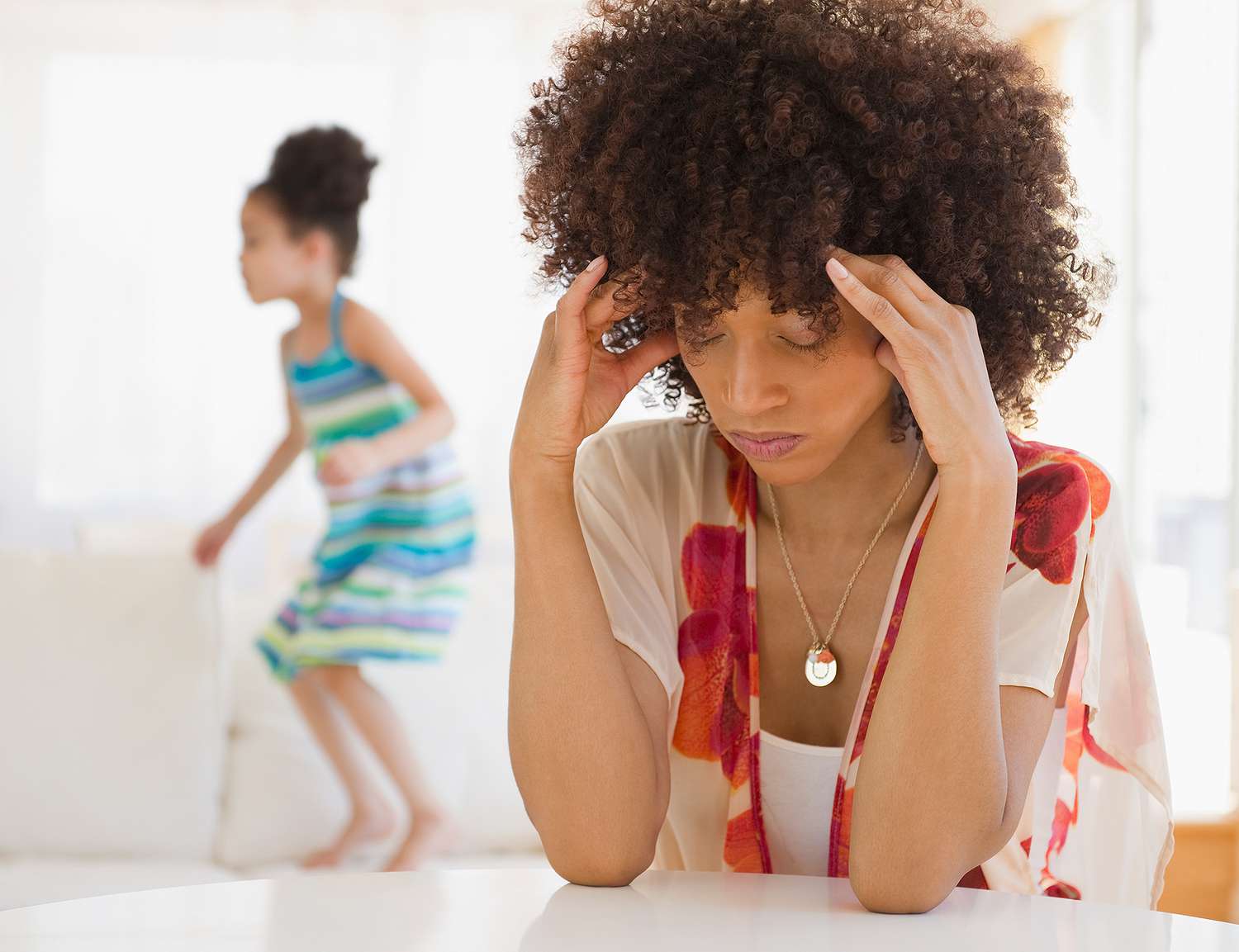
Parenting during a pandemic is a challenge, to say the least. Due to the stress of family health concerns, financial strain, accommodating your children’s remote learning, plus the sheer exhaustion of juggling so many issues at once, many moms (and dads) feel understandably overwhelmed.
To make managing work-life balance even more difficult: All of this stress and anxiety can trigger any number of health issues. One in particular on the rise is migraine, a neurological condition that can cause intense and debilitating headaches, nausea, sensitivity to light and more.
According to Dawn Buse, Ph.D., Clinical Professor in the Department of Neurology at Albert Einstein College of Medicine and a board member of the American Headache Society, migraine is a chronic illness with episodic attacks that can last anywhere from a few hours to days. Dr. Charisse Litchman, a neurologist specializing in headache medicine and former Assistant Professor of Clinical Neurology at Yale School of Medicine, tells PEOPLE that migraines are three times more common in women than in men, with 17% of women getting migraines as compared to 6% of men. “Women tend to have more severe pain and their headaches last longer,” says Dr. Litchman.
That means for the mothers among the approximate 30 million American women suffering from migraine, who are currently experiencing uprooted childcare and work situations, they're managing parenting and work responsibility in the midst of prolonged and chronic pain. For some mothers, migraines occurred as a symptom of the disease itself.
Katie H., 42, a nurse and mom of a 5-year-old boy from Hamden, CT, tells PEOPLE that her battle with migraine began around puberty and has worsened after pregnancy. “Even now, the headaches are centered around and often triggered by my period,” she says. (This aligns with research connecting migraine incidence with hormonal shifts in women. Over 90 percent of people with migraines start having attacks before age 40, and most start in their teens and twenties.)
In April, Katie contracted Covid while working at the hospital. “Covid exacerbated my worst symptom: migraine,” she says. “I had a migraine almost the entire time I had Covid. The headache would just sit there. Basically, I had a migraine for three weeks. It just kept coming back. Aside from Covid, I might get a bad one for three days. I’m relieved when it’s finally over, but exhausted.”
Fortunately, Katie’s son is now old enough to understand when she’s feeling sick. “When he was really little, I’d have to call my husband to come home, but from 3 years old on he understood. I say, ‘Mommy has a headache. Just let me sit here, please’,” she says. “He’s really good, I can put on a movie for him now.” Katie’s advice to other moms is to stay hydrated and to take care of yourself. “Who cares if the house is a little dirty? Get some extra rest!”
Dr. Buse, who’s also an advisor and speaker at Migraine World Summit, echoes that self-care is essential right now. “It may feel like there is less time than ever to care for yourself, but self-care is essential in managing migraine. When you care for yourself and manage your migraine, you will be better able to care for others,” she says. “Proper nutrition, good sleep habits, regular exercise and managing stress can all help raise the threshold for a migraine attack … It can be helpful to keep a diary to track attacks; set reminders throughout the day to practice healthy breathing and gentle stretching, even for 30 seconds at a time. There are many apps today which can help track and guide healthy habits and relaxation practices.”

Dr. Litchman tells PEOPLE that since the start of the pandemic, there’s been a significant uptick in both the number of people who are newly experiencing migraines and how often migraines are occurring in those who already suffer from them. (A migraine-tracking app, MigraineBuddy, has seen a 20 percent rise in migraine reports.)
“The reason we are seeing people who have always suffered from migraines experience more migraines is that they are being exposed to more triggers,” says Litchman. “Those experiencing migraines for the first time likely have always had a predisposition to migraines, and they are experiencing [them] for the first time now because they also are exposed to so many new triggers.” Triggers include changes in hormones, excess caffeine, stress (including financial stress), disrupted sleep and meal patterns, plus many potential food triggers.
RELATED PHOTOS: Celebrities who suffer from migraines
Bridget P., a 43-year-old mom from Waterford, CT, tells PEOPLE that avoiding trigger foods is a major part of her migraine management plan. She avoids alcohol, chocolate, peanuts, citrus fruits and MSG, tries to keep a very regular sleep schedule, and avoids very strenuous exercise. “I have noticed that my migraines have increased since the start of the pandemic,” she says. “The three people with whom I live are all high-risk for severe Covid infection, and my anxiety has been very high. I was furloughed for four months, but unable to qualify for unemployment during most of that time … I have had two severe migraines which lasted more than five days each, and my typical treatments did not work.”
Stress is a major trigger factor triggering for headaches, which explains the higher incidence during the pandemic. “The pandemic has placed great challenges on people around the world and added even greater burden to people living with migraine potentially, ” Dr. Buse tells PEOPLE, adding that the bandwidth for the self-care she recommends is in increasingly short supply for most people, parents included. “In addition to the health crisis, we are living through economic, political and racial equity and civil rights crises, as well. Living with migraine is difficult at any time, and living with migraine in 2020 has been extremely challenging for millions of people. Parents already have little time for self-care, and the extra challenges of 2020 have made that time feel nonexistent.”

Bridget, who is a single parent, an adjunct professor at a liberal arts college and small business owner, is homeschooling her 8-year-old son. “I am working remotely for all three of my jobs while also managing full homeschooling, not distance learning, for my [third grader]. It is a challenge, and some days feel very overwhelming,” she says. “I do not have any down time on weekends, as I spend weekends prepping for the week of homeschool and catching up on work. My schedule is exhausting. Dealing with a migraine as a single mom is a huge challenge. I am so lucky to have my parents in the house, so I do feel comfortable taking a short break if necessary.”
Dr. Litchman says 84 percent of people who experience migraines report that the pandemic has negatively impacted their ability to manage them, due to factors including decreased access to care and medication. Litchman, who is also the medical advisor in neurology at Nurx, a digital practice for women’s health offering personalized treatment for headaches and migraines, says it’s important to take headaches seriously as they may be a Covid-19 symptom. “Approximately 13 percent of patients with Covid-19 experience a headache, and the headache is the fifth most common symptom,” she says. “If someone develops a new or different headache along with fever, cough, muscle aches, difficulty breathing and/or loss of taste or smell, they should get tested for Covid.”
If you’re a parent experiencing non-Covid-related migraines, try to reassure your kids there are no long-term consequences and you'll be back to being yourself before too long, recommends Dr. Buse. Take it easy on yourself, and don't feel guilty asking for help (or turning on the TV) so you can rest and recover. In the case of daily migraine or continuous pain, parents should be forthcoming about how they are managing attacks. Explaining to kids that mom is under care of a doctor and detailing how treatment will make them feel better as quickly as possible can help reduce stress for the whole family.
Source: Read Full Article